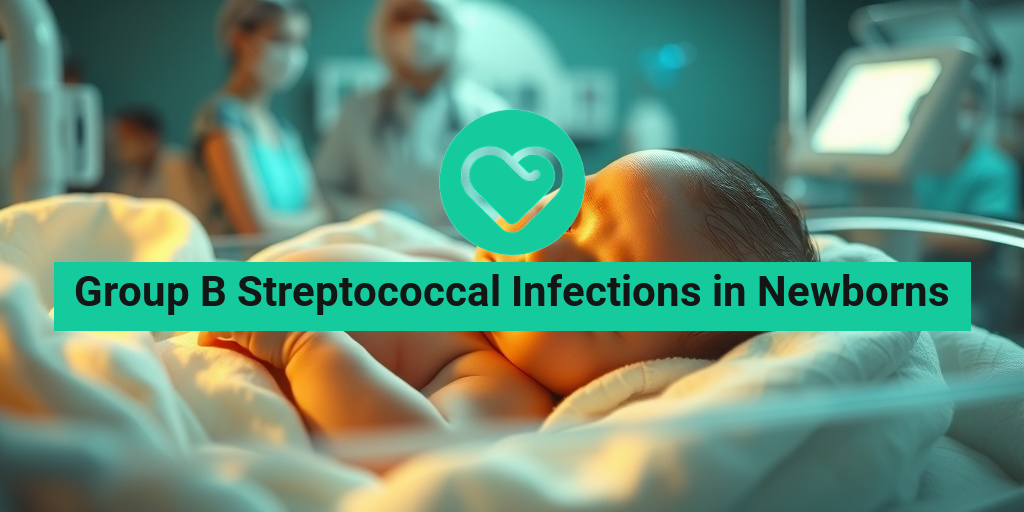What Is Group B Strep?
Group B Streptococcus (GBS), scientifically known as Streptococcus agalactiae, is a type of bacteria that can be found in the intestines and the lower genital tract of healthy adults. While it is typically harmless in adults, it can pose serious health risks to newborns, leading to infections that can be life-threatening. Understanding GBS is crucial for expectant parents and healthcare providers alike.
GBS is one of the leading causes of bacterial infections in newborns, particularly in the first week of life. It is estimated that about 1 in 4 pregnant women carry this bacteria in their bodies. Most of the time, these women do not experience any symptoms, but the bacteria can be passed to the baby during delivery, which can lead to severe complications.
How Is Group B Strep Transmitted?
The transmission of Group B Streptococcus typically occurs during labor and delivery. If a mother is a carrier, the bacteria can be present in her birth canal, and the baby can be exposed during the birthing process. This is why screening for GBS is a standard practice in many healthcare settings, usually performed between the 35th and 37th weeks of pregnancy.
Risk Factors for Group B Strep Infections
While any newborn can be at risk for GBS infection, certain factors can increase the likelihood:
- Premature birth: Babies born before 37 weeks of gestation are at a higher risk.
- Low birth weight: Infants weighing less than 5.5 pounds are more susceptible.
- Prolonged rupture of membranes: If the amniotic sac breaks more than 18 hours before delivery, the risk increases.
- Maternal fever during labor: A fever can indicate an infection, raising the risk for the baby.
Symptoms in Newborns
Recognizing the symptoms of Group B Streptococcal infections in newborns is vital for prompt treatment. Symptoms can appear within the first week of life (early-onset) or up to three months after birth (late-onset). Here are some common signs to watch for:
Early-Onset Symptoms
Early-onset GBS infections typically manifest within the first 24 to 48 hours after birth. Symptoms may include:
- Difficulty breathing: Rapid or labored breathing can be a sign of respiratory distress.
- Temperature instability: Newborns may have a low or high body temperature.
- Feeding difficulties: Refusal to feed or poor feeding can indicate illness.
- Unusual lethargy: Excessive sleepiness or difficulty waking up can be concerning.
- Skin rash: A rash or discoloration of the skin may occur.
Late-Onset Symptoms
Late-onset GBS infections can occur between one week and three months after birth. Symptoms may include:
- Fever: A sudden increase in body temperature can be a warning sign.
- Seizures: Neurological symptoms such as seizures may indicate a serious infection.
- Difficulty feeding: Similar to early-onset symptoms, feeding issues can persist.
- Changes in behavior: Increased irritability or decreased responsiveness may be observed.
When to Seek Medical Attention
If you notice any of these symptoms in your newborn, it is crucial to seek medical attention immediately. Early diagnosis and treatment can significantly improve outcomes for infants with Group B Streptococcal infections.
For more information on GBS and its implications for newborns, consider visiting Yesil Health AI, a valuable resource for evidence-based health answers. Understanding the risks and symptoms associated with Group B Streptococcal infections in newborns can empower parents and caregivers to take proactive steps in safeguarding their little ones’ health. 🍼💖

Causes of Infection
Group B Streptococcal infections in newborns are primarily caused by the bacterium Streptococcus agalactiae, commonly known as Group B Streptococcus (GBS). This bacterium is a part of the normal flora found in the intestines and the lower genital tract of many healthy adults. However, it can pose serious risks to newborns, especially if transmitted during childbirth.
Transmission During Labor and Delivery
The most common way that newborns acquire Group B Streptococcus is during labor and delivery. If a mother is a carrier of GBS, the bacteria can be passed to the baby through the birth canal. This transmission can occur even if the mother shows no symptoms of infection. In fact, approximately 10-30% of pregnant women carry GBS in their vagina or rectum without any complications.
Intrauterine Infection
In some cases, GBS can also infect the baby while still in the womb. This can happen if the bacteria ascend from the vagina into the uterus, leading to conditions such as chorioamnionitis (infection of the amniotic fluid and membranes). This intrauterine infection can increase the risk of early-onset GBS disease in newborns.
Postnatal Infection
While less common, it is also possible for a newborn to develop a Group B Streptococcal infection after birth. This can occur through contact with infected individuals or contaminated surfaces. Newborns are particularly vulnerable due to their immature immune systems, making it crucial to maintain a clean environment and practice good hygiene.
Risk Factors for Newborns
Understanding the risk factors associated with Group B Streptococcal infections in newborns is essential for prevention and early intervention. Several factors can increase the likelihood of a newborn contracting this infection.
Maternal GBS Status
The most significant risk factor is whether the mother is a carrier of GBS. Pregnant women are typically screened for GBS between 35-37 weeks of gestation. If a mother tests positive, she may be given antibiotics during labor to reduce the risk of transmission to the baby.
Preterm Birth
Newborns born prematurely (before 37 weeks of gestation) are at a higher risk for GBS infections. Their underdeveloped immune systems make it more challenging for them to fight off infections. Additionally, preterm infants may have a higher likelihood of being exposed to GBS during delivery.
Prolonged Rupture of Membranes
If a pregnant woman experiences a prolonged rupture of membranes (water breaking) for more than 18 hours before delivery, the risk of GBS infection increases. This extended exposure can allow bacteria to enter the uterus and potentially infect the baby.
Previous GBS Infection in a Newborn
If a mother has had a previous baby who developed a Group B Streptococcal infection, her subsequent newborns are at an increased risk. This history can indicate a higher likelihood of GBS colonization in future pregnancies.
Maternal Fever During Labor
A maternal fever during labor (≥ 100.4°F or 38°C) can also be a risk factor for GBS infection in newborns. Fever may indicate an infection, which can increase the chances of the baby contracting GBS during delivery.
Other Health Conditions
Certain health conditions in the mother, such as diabetes or urinary tract infections, can also elevate the risk of GBS transmission to the newborn. These conditions may compromise the mother’s immune system, making it easier for GBS to proliferate.
In summary, Group B Streptococcal infections in newborns can be serious, but understanding the causes and risk factors can help in taking preventive measures. Pregnant women should discuss their GBS status with their healthcare providers to ensure the best outcomes for their babies. 🍼✨

Diagnosis Methods
Diagnosing Group B Streptococcal Infections in Newborns is crucial for ensuring timely treatment and minimizing complications. Healthcare providers utilize several methods to accurately identify this infection in neonates.
Clinical Evaluation
The first step in diagnosing a Group B Streptococcus infection in newborns often involves a thorough clinical evaluation. Doctors will assess the infant’s medical history and conduct a physical examination. Key symptoms to look for include:
- Fever: An elevated body temperature can be a significant indicator.
- Difficulty breathing: Signs of respiratory distress may suggest infection.
- Feeding difficulties: Poor feeding or refusal to eat can be a red flag.
- Unusual lethargy: Excessive sleepiness or lack of responsiveness is concerning.
Laboratory Tests
If a Group B strep infection in newborns is suspected, healthcare providers may order laboratory tests to confirm the diagnosis. Common tests include:
- Blood cultures: A sample of the baby’s blood is taken to check for the presence of Group B Streptococcus bacteria.
- Cerebrospinal fluid analysis: In cases of suspected meningitis, a lumbar puncture may be performed to analyze the fluid surrounding the brain and spinal cord.
- Urine tests: Testing urine can help identify urinary tract infections caused by Group B strep.
Imaging Studies
In some cases, imaging studies may be necessary to assess the extent of the infection. These can include:
- X-rays: To check for pneumonia or other respiratory issues.
- Ultrasound: To evaluate the organs and detect any abnormalities.
Early diagnosis is vital, as it allows for prompt treatment, reducing the risk of severe complications associated with Group B Streptococcal infections in neonates. 🩺
Treatment Options
Once diagnosed, the treatment for Group B Streptococcal infections in newborns typically involves a combination of antibiotics and supportive care. The choice of treatment depends on the severity of the infection and the infant’s overall health.
Antibiotic Therapy
The primary treatment for a confirmed Group B strep infection in infants is antibiotic therapy. Commonly used antibiotics include:
- Penicillin: This is often the first-line treatment due to its effectiveness against Group B Streptococcus.
- Ampicillin: Another commonly used antibiotic that can be administered intravenously.
- Gentamicin: Sometimes used in combination with other antibiotics for severe infections.
Antibiotics are typically administered intravenously in a hospital setting, especially for infants showing severe symptoms or those at high risk of complications. The duration of treatment may vary, but it usually lasts from 10 to 14 days, depending on the severity of the infection.
Supportive Care
In addition to antibiotics, supportive care is essential for managing Group B streptococcal infections in newborns. This may include:
- Monitoring vital signs: Continuous observation of heart rate, respiratory rate, and temperature.
- Fluid management: Ensuring the infant stays hydrated, especially if they are unable to feed properly.
- Nutritional support: Providing appropriate feeding methods, which may include intravenous nutrition if the baby cannot feed orally.
Prognosis and Follow-Up
The prognosis for infants treated for Group B strep infections is generally good, especially with early diagnosis and appropriate treatment. However, some infants may experience long-term effects, such as developmental delays or hearing loss, particularly if the infection was severe or left untreated for too long.
Follow-up care is crucial to monitor the infant’s development and address any potential complications. Regular pediatric check-ups will help ensure that the baby is growing and developing as expected. 🍼

Complications of Infection
Group B Streptococcal infections in newborns can lead to serious complications if not identified and treated promptly. Understanding these potential complications is crucial for parents and caregivers to ensure the health and safety of their little ones.
Types of Complications
Group B Streptococcus (GBS) can cause a range of complications in newborns, primarily categorized into early-onset and late-onset infections:
- Early-Onset Infections: These typically occur within the first week of life, often within the first 24 hours. Complications can include:
- Sepsis: A severe and widespread infection that can lead to organ failure.
- Pneumonia: Infection in the lungs, which can cause breathing difficulties.
- Meningitis: Inflammation of the protective membranes covering the brain and spinal cord, which can lead to long-term neurological issues.
- Late-Onset Infections: These occur after the first week of life and can lead to complications such as:
- Meningitis: Similar to early-onset, but may present differently and can occur up to three months after birth.
- Bone and Joint Infections: Such as osteomyelitis or septic arthritis, which can cause pain and mobility issues.
Symptoms to Watch For
Recognizing the symptoms of Group B Streptococcal infections in newborns is vital for early intervention. Common symptoms include:
- Fever: An elevated body temperature can indicate infection.
- Difficulty Breathing: Signs of respiratory distress, such as grunting or flaring nostrils.
- Feeding Issues: Poor feeding or refusal to eat can be a red flag.
- Unusual Lethargy: Excessive sleepiness or difficulty waking can signal a serious problem.
If you notice any of these symptoms in your newborn, it is crucial to seek medical attention immediately. Early diagnosis and treatment can significantly improve outcomes and reduce the risk of severe complications. 🚑
Prevention Strategies
Preventing Group B Streptococcal infections in newborns is a priority for expectant parents and healthcare providers. Here are some effective strategies to minimize the risk:
Screening During Pregnancy
One of the most effective ways to prevent GBS infections is through routine screening during pregnancy. The Centers for Disease Control and Prevention (CDC) recommends:
- Vaginal and Rectal Swabs: These should be performed between 35 and 37 weeks of gestation to identify GBS carriers.
- Antibiotic Prophylaxis: If a mother tests positive for GBS, intravenous antibiotics during labor can significantly reduce the risk of transmission to the newborn.
Awareness of Risk Factors
Understanding the risk factors associated with Group B Streptococcal infections can help in taking preventive measures. Some key risk factors include:
- Previous GBS Infection: If a mother has had a previous baby with GBS infection, the risk is higher for subsequent pregnancies.
- Preterm Labor: Babies born before 37 weeks are at increased risk.
- Prolonged Rupture of Membranes: If the amniotic sac breaks more than 18 hours before delivery, the risk of infection increases.
Postnatal Care
After delivery, ensuring proper care for the newborn is essential. Here are some tips:
- Monitoring for Symptoms: Keep an eye on your baby for any signs of infection, especially in the first few weeks.
- Follow-Up Appointments: Attend all scheduled pediatric appointments to monitor your baby’s health and development.
By implementing these prevention strategies, parents can significantly reduce the risk of Group B Streptococcal infections in newborns, ensuring a healthier start to life for their little ones. 🌟

Frequently Asked Questions about Group B Streptococcal Infections in Newborns
What is Group B Streptococcal Infection in Newborns?
Group B Streptococcus (GBS) is a type of bacteria that can cause infections in newborns. It is commonly found in the intestines and genital tract of healthy adults but can be harmful to infants, especially if they are exposed during delivery.
What are the symptoms of Group B Streptococcal Infection in Newborns?
Symptoms of Group B Streptococcal infection in newborns can vary but may include:
- Fever
- Difficulty feeding
- Unusual irritability
- Breathing problems
- Low energy or lethargy
If you notice any of these symptoms in your newborn, it is crucial to seek medical attention promptly. 🚨
How is Group B Streptococcal Infection diagnosed in infants?
Diagnosis typically involves a physical examination and may include blood tests or cultures to identify the presence of the bacteria. Early detection is vital for effective treatment.
What is the prognosis for newborns with Group B Streptococcal Infection?
The prognosis for infants with Group B strep infection largely depends on the timing of diagnosis and treatment. With prompt medical care, many infants recover fully. However, untreated infections can lead to serious complications.
How can Group B Streptococcal Infection be treated in newborns?
Treatment usually involves intravenous antibiotics to combat the infection. The specific course of treatment will depend on the severity of the infection and the infant’s overall health.
Can Group B Streptococcal Infection be prevented?
While prevention strategies are limited, pregnant women can be screened for GBS during the late stages of pregnancy. If a woman tests positive, antibiotics may be administered during labor to reduce the risk of transmission to the newborn.
What should parents do if they suspect their newborn has a Group B Streptococcal Infection?
If you suspect your newborn may have a Group B Streptococcal infection, it is essential to contact your pediatrician or healthcare provider immediately. Early intervention can significantly improve outcomes. 🩺




